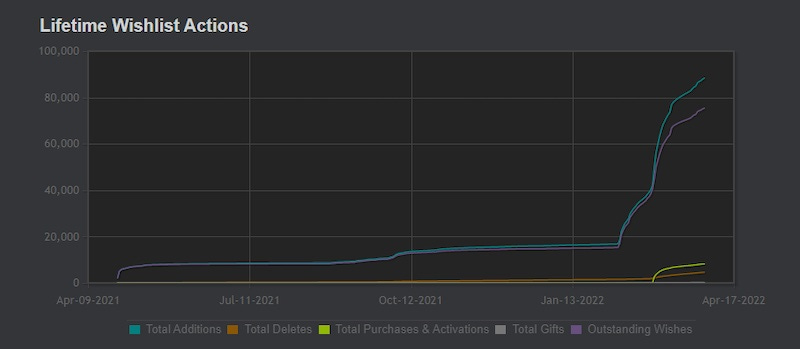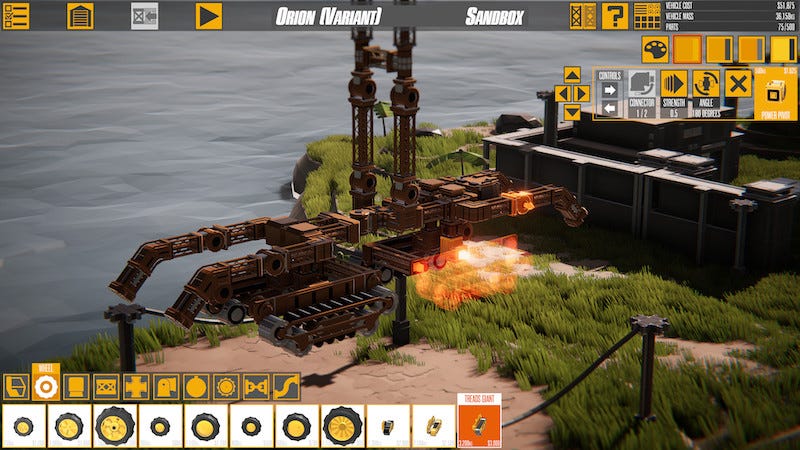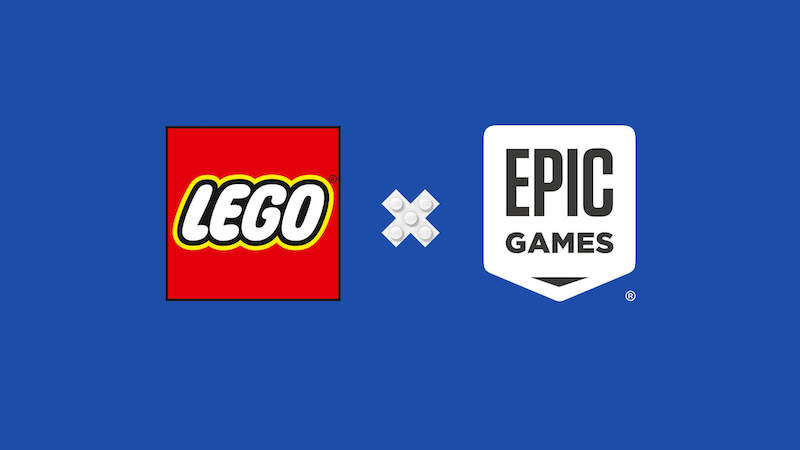Instruments Of Destruction's 'build & smash' launch - deconstructed
Also: Epic gets $2 billion from Sony and Lego's parents.
[The GameDiscoverCo game discovery newsletter is written by ‘how people find your game’ expert & company founder Simon Carless, and is a regular look at how people discover and buy video games in the 2020s.]
Another week in paradise - or at least, ‘the Internet & wherever you are reading this’. Hope you had a marvelous weekend, and are raring to go for a week of chills, thrills and spills finding people to play and universalize our IP.
And after a week that actually brought the announcement of a Myst themed mini-golf DLC, we’re eagerly awaiting the following fictional IP extensions: a Moss-licensed version of the Mouse Trap board game, and a golf game based on The Last Of Us 2. No? No! Fine: let’s go.
[Help us flourish, and get analysis, data, and peer feedback all at the same time? Our GameDiscoverCo Plus paid sub has a data-rich weekly game trends analysis, interactive Steam ‘Hype’ charts, two eBooks, a member-only Discord & more. Sign up today!]
Instruments Of Destruction: how Steam launch went & why!
The developer behind Instruments Of Destruction, Luke Schneider of Radiangames, is a solo indie with an intriguing history. I’ve known him for a few years thanks to his Xbox Live Indie Games titles (!) like twin-stick shooter Inferno, and more recent mobile games like Apple Arcade launch title (and super good time!) Speed Demons.
Formerly lead multiplayer and lead technical designer on Volition’s destruction-heavy Red Faction: Guerrilla, Luke’s latest title, Instruments Of Destruction, launched on Steam Early Access on March 2nd. It had 3,906 units sold on launch day, after a pre-launch period that included notable buzz and more than 50 (!) publishers reaching out.
The game - which GameDiscoverCo consulted minorly with Luke on during pre-release, btw - is “a vehicle-building sandbox featuring advanced physics-based destruction”, in which you “create crazy construction vehicles and use them to demolish buildings and complete various objectives.” This is a hot subgenre at times: see Besiege, etc.
Factsheet: IoD’s launch, by the numbers?
Just running down the sales numbers for this title in its first month on release (above), courtesy of Luke, who chose to launch & iterate on Steam first, since he “needs to streamline development as much as possible” as a one-man dev:
Units: 17,880 (with 265 Steam reviews, so 65 sales per review - Early Access titles can trend way higher on the sales/review ratio.)
First week sales: 11,167 units, after launching with 40,432 wishlists - that’s 0.27, slightly better than a median of 0.2.
Refunds: 2,855 (16% - a bit high, but we’ll discuss later!)
Net Units: 15,025
Net revenue (after returns/taxes, but before 30% Steam cut): $229,628
Regional sales: 34% United States; 12% Germany; 10% Japan; 7% United Kingdom; 4% Canada; 3% Australia, everything else 2% or less.
Finally, the game essentially doubled its ‘outstanding’ Steam wishlists from over 40,000 at launch to nearly 80,000 a month after launch, as can be seen above. And it’s still adding new wishlists quite aggressively - often hundreds per day, with sales still at 150-200 units per day, a month after launch.
Seems like the long-term prognosis for Instruments Of Destruction is good. Maybe it didn’t ‘pop’ big at launch, with a top all-time CCU of 330. (The market is busy nowadays, and it’s Early Access.) But it’s a great result for a solo dev - a Top 50 new game on Steam in March by reviews in first week, according to our Plus data, with a near-median ‘Hype to reality’ score of 0.15. Plenty of ‘long tail’ and upside possible...
Anyhow, time to hand this article over to Luke himself. We asked him to contribute a list of the top 3 things he thought helped the game do well - and the top 3 things that totally didn’t help:
Luke’s view: the top 3 things that helped the game do good!
1. A YouTube focus…
I've heard a lot about replayability and user generated content being important. And I've had content creators in mind for a while with Instruments of Destruction. My first big push after the announce trailer was to get a build ready for YouTubers.
I slowly collected email addresses (5 per day, thanks Google!) from YouTubers who covered similar games like Besiege, Scrap Mechanic, Trail Makers, and Teardown. I also looked for anyone still around who had positive things to say about Red Faction Guerrilla. In August 2021 I emailed 80 YouTubers with a build - and about 10 or so covered the game or responded in some way.
And once the release date trailer was nearing, I emailed about 100 YouTubers, with previous players getting the build earlier than everyone else. The response was even better the second time - and I even got some large YouTubers emailing me to ask for Steam keys.
Now a month into Early Access, the game has been covered by lots of YouTubers, many with over 1 million subscribers. It's also shown up as semi-regular episodes for a few of them. I haven't been keeping track of total views, but I'd guess it's in the 20-30 million range at this point, and I expect a lot more coverage in the future.
2. Trailers, especially the ‘Release Date’ trailer
On February 10th, the game was set to launch in 3 weeks. It had just passed 15k wishlists, 9 months after being announced. Then I sent out the Release Date Trailer, which featured a custom song that definitely struck a chord. Over the next 3 weeks, the game accumulated an additional 25k wishlists and launched with a ton of momentum.
The song for this trailer had been recorded in mid-2020, so I'd had a lot of time to think about what I wanted in the trailer. The Announce Trailer back in April of 2021 had been a big hit, and the Launch Day Trailer turned out quite well for something that was thrown together in a few days.
But it was the Release Date Trailer that went semi-viral and really set the tone for the launch of the game. Though the trailers may have caused some unrealistic expectations (see below), they have definitely helped draw in more players than would normally be interested in a vehicle-building game.
3. A visual overhaul…
One thing I had noticed back in September while watching YouTube coverage was that the game looked nice, but didn't really stand out visually. The destruction was cool enough, but it wasn't visually impressive in a way that made people excited to play the game.
I had been working on a demo for the Steam Next Fest (which went fine), so I had a bit of time to think about how improve the visuals. Immediately after the Next Fest ended, I made a decision to try my hand at compute shaders for a custom particle system and water improvements. The alternative had been to throw all my custom shaders out and switch to Unity's HDRP.
I ended up throwing out most of my shaders anyway, as once I started down the compute shader rabbit hole, there was no going back. The amount of changes is too long to list here (here’s way more details!), but suffice to say that the game's visuals were almost completely redone.
The main thing this enabled was just putting a lot more *stuff* on the screen at once, which is really important for destruction looking good. Once the visual changes were wrapping up, I was able to focus on the Release Date Trailer and planning for the Early Access Release. I had been working very hard on the changes in secret for over 3 months, but once I saw the reaction on YouTube and to the trailer, I knew the time was well-spent.
Luke’s view: the bottom 3 things that hurt the game’s prospects?
1. The refund rate…
Instruments of Destruction may have a very high review score so far (98% positive after 290 reviews), but that's partly because people who don't like the game are returning it. The refund rate is now up to 16%, - though it's pretty much leveled off at this point. Based on the feedback in the refund notes, there are a few problems:
Some people don't read the description, and didn't realize it's a vehicle builder.
The build tutorial is pretty weak. (Many people also don't realize there are pre-made vehicles.)
The amount of main campaign content is a bit light (3-5 hours, depending on your play style.)
That content is pretty good, but not as exciting as the trailers.
There were some technical issues as well (with old AMD cards, etc) - but those have been fixed up.
So far, I've done little to combat the refund rate, and I don't plan to do more for a couple months. I need to create a new trailer that focuses more on actual gameplay instead of highlights, I need to improve the tutorial, and I need to add more content (and spice it up).
Basically I'm ignoring the problem for a while, and choosing to not promote the game until at least a couple of the issues above are improved. I know that sounds weird to ignore such large problems, but long-term efficiency and overall quality is more important to me.
My current development path (adding in-game editors before addressing the issues above) will get me there eventually. And long-term, the quality of the game will be higher. By the time the Steam Summer Sale rolls around, the game will be ready for a new influx of players.
2. (Not) hiring help…
After the initial announcement, I was contacted by over 20 publishers. I was seriously considering with working with a publisher, but only if I was able to hire a programmer to help. I had two programmers that I offered jobs to, but one took a different job, while the other was committed to another project until the end of 2022.
I also tried to hire a PR/video/do-everything person a bit later, but that didn't work out either, partly because I didn't have anyone in mind, and I didn't dedicate enough time to finding someone. I had good luck connecting with musician Auvic in 2018 for Speed Demons' soundtrack (he's also doing all the music for Instruments of Destruction), and there are people I semi-regularly chat with on Discord.
But I'm working solo in my basement for the most part. I'm quite used to solo indie work and have been very efficient, but this is a big game with a lot to do, and some days I just don't want to do everything myself.
3. Inconsistent social media?
Good promotion takes time, and I don't have much of it. I also suck at multi-tasking, as I get distracted easily when I'm trying to do multiple things at once. From gameplay GIFs to behind-the-scenes videos, anything that requires a consistent time commitment ends up falling to the side, as I focus on development. I also quickly lose interest if a couple GIFs/videos don't gain the traction I expected.
The only thing I've been able to do consistently (outside of working on the game itself) is check the game's Discord and Steam Forums. Even that comes and goes a bit. But I think I'll be able to stick with it because I'm doing regular game updates, and the interaction/feedback is part of that process.
Luke’s conclusion: turned out nice again?
After a month, things have gone really well for Instruments of Destruction, and I'm excited to keep working on it until at least mid-2023. While it's felt like a bit of a roller-coaster to get here, that's more of perception problem on my part.
The high refund rate will be in the back of my mind until it's under control. But my overall strategy for the game has remained the same for two years and I don't see a reason to change now. This is a long-tail game, and I'll continue to focus on long-term quality above all else.
[Simon’s note: def. agree with the above - I think the refund rate issues are the only major negative in terms of actually impeding revenue/sales, and that will definitely change as more features and depth gets built into the game. Thanks to Luke for his transparency!]
The game discovery news round-up..
So the lead item went pretty long today (lots of good info!) Thus, we’ll skip our ‘B’ story and go straight to our round-up of platforms and discovery news. Which goes a little something like this:
The announcement that Epic and Lego are teaming up “to build an immersive, creatively inspiring and engaging digital experience for kids of all ages to enjoy together” seems notable to me. Oh, and late breaking news: Lego’s owners put $1 billion into Epic, as did Sony, at a $31.5 billion valuation. That’s a serious extra warchest, or cashing out some more employees, or both?
Valve made a comprehensive blog post about Steam Deck’s first month on sale, including 2,000 games being now officially Deck Verified or Playable, the fact that “we’ve spent some time making the Steam Store more responsive and snappier on Deck”, and info on the expansion of anti-cheat tech for Deck, allowing Apex Legends to be playable on the device.
A bit more hype from Jim Ryan about PlayStation Plus’ reboot: “We have big publishers, we have small indie publishers. We have over 200 partners working with us to put their content into PlayStation Plus.” But not Day 1 first-party: “Putting these games into a subscription service immediately upon their release would break this virtuous circle, and we wouldn’t be able to invest in the way that we’re currently able to.”
Having been behind the scenes at GDC for 15+ years before starting GameDiscoverCo (coincidental acronym, btw!), I thought this New Yorker piece on GDC 2022 did a great job of communicating the messy tensions around ‘destination’ events. Unionization, crypto, capitalism and COVID: culture clash is generally on display at the show, and certainly so this year.
This interview with the Guardians Of The Galaxy devs at the BAFTAs has an interesting quote from narrative lead Mary DeMarle: “What I love right now is that people, especially with Game Pass, are playing it and they're sharing the experience.” So the extra reach - allegedly alongside a $5-$10 mil Xbox payment - really helped. But the commercial underperformance upfront shows why very big-budget single player titles can have rough returns nowadays.
Chris Zukowski followed Axios’ Stephen Totilo around GDC (with his permission, lol?), and did a good anthropological study of a game demo-er in his native habitat. Highlight: “Content creators have TONs of games to go through during shows. They just want to see what type of game you have. Focus on GENRE, GAME TYPE, GAMEPLAY, VERBS. Avoid deep diving LORE, SETTING, NOUNS.”
Brave At Night’s Alina Cebula did the ‘wishlist conversion % by month’ post-releasse thing for Mind Scanners conversions. She found out LudoNarraCon & Steam NextFest appearances for the game (both with demo available!) didn’t reduce conversion rate. Valve’s own stats for Next Fests do say there’s some conversion dilution (1,364% more wishlists, 500% more converting wishlists), but that’s a median result, so not representative of all. (Nice work!)
Microlinks: Improbable has improbably raised another $150 million to pivot further metaverse-wards; Nvidia won’t make you sign into Steam or Epic to try its free new cloud gaming demos; Tencent is closing its Twitch-like Penguin Esports platform in China.
Finally, since I know a lot of us see (or make!) pitch documents for games a lot: here’s a video game pitch document that you might not be expecting:
[We’re GameDiscoverCo, an agency based around one simple issue: how do players find, buy and enjoy your premium PC or console game? We run the newsletter you’re reading, and provide consulting services for publishers, funds, and other smart game industry folks.]







Really enjoying the breakdown of what they could be doing better on social media. Every time I explain to a company who wants to "make content" around their thing, I emphasize that it's a loss leader that needs to be consistent to be successful; the whole "interest fell off" thing is super real, because without clear value or good feedback, it falls down the list of things people want to do, especially when they're wearing many hats.